In the late 80s and early 90s, a small group of Japanese jeans fanatics in the city of Osaka went on a quest for the perfect jeans. Their pursuit for the best denim would eventually unleash a jeans boom that has thoroughly changed the global jeans market.
Jeans are as American as you can get. But the jeans that American companies like Levi’s, Lee and Wrangler make today are far removed from those that American icons like James Dean and Elvis Presley wore. Production of raw, unwashed denim was discontinued in the US in the 1960s; the old looms and the skilled workers that produced it vanished soon after.
At some time in the late 1980s this was starting to bother two employees of Lapine, a small fashion store in Osaka. “I really liked Levi’s 501,” recalls Hidehiko Yamane, one of the two, now well known as the founder of EVISU. “But in the 1980s, jeans were changing. The quality of the sewing was going down, rivets were different, the material was not the same anymore, and they even used plastic buttons. I thought this was weird, so I started to research how jeans were made.”
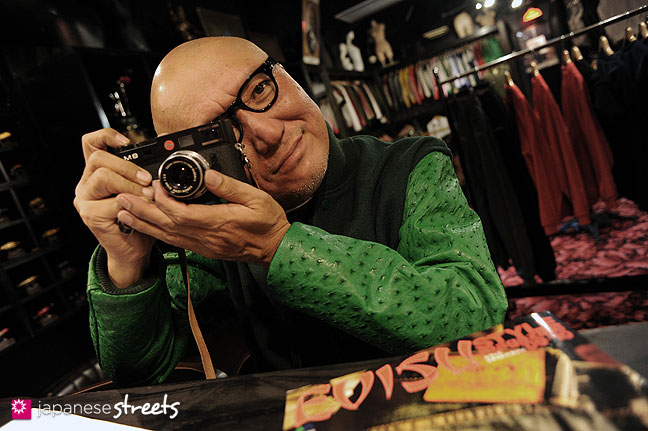
EVISU founder Hidehiko Yamane
“At the time, many Japanese bought vintage jeans from the US,” remembers Mikiharu Tsujita, the second employee, now owner of FULLCOUNT. “It was becoming more and more difficult to find them, and they were becoming expensive. So Yamane and I suggested that we’d make vintage jeans ourselves.”
Lapine’s owner, Saburo Fujimoto, initially went ahead with their plans, but when it became time to pay for a batch of denim, he balked. “Japan’s economic bubble had just burst,” says Yamane, “so he probably didn’t really have the money anymore.”
But Yamane had already made the denim, and had also fallen deeply in love with the project itself. He decided that if Fujimoto wouldn’t, he’d do it himself. In February 1991 he quit his job. Two months later he started the company that would grow into EVISU.
By 1992, Yamane had made hist first 300 pairs of jeans. Popular Japanese magazine mono happened upon them, liked what they saw, and introduced them on their pages. Sales took off.
Soon, Yamane was assisted by Tsujita, and two former customers from Lapine, the Shiotani brothers. They didn’t stay very long. Tsujita started FULLCOUNT in 1992, while the Shiotani brothers started their own company, WAREHOUSE, in 1995. Each one following his own vision of what the perfect jeans should look like.

FULLCOUNT founder Mikiharu Tsujita
These three however were not the only ones in search of the holy grail of vintage jeans. In 1988, Kobe based fashion manufacturer World Co. had launched Denime under the leadership of Yoshiyuki Hayashi. Six years before that, Shigeharu Tagaki, possibly Japan’s top expert on vintage jeans, had founded STUDIO D’ARTISAN.
Surprisingly, all these pioneers were located in the same region. STUDIO D’ARTISAN, EVISU, FULLCOUNT and WAREHOUSE in Osaka, Denime in Kobe, a city neighboring Osaka.
This happened partly because they were all friends with the same passion for jeans. “We all knew each other,” says Hayashi. “We used to get together and discuss how we could make the best jeans.”
This could only have been possible in Osaka’s open culture. “People here don’t hide information,” says Hayashi with a broad grin. “To people in Tokyo the idea that you share information with competitors is incomprehensible.”

Denime founder and current RESOLUTE director Yoshiyuki Hayashi
This closeness and open sharing created an intense rivalry. “We were always very aware of what the others were doing,” says Tsujita, “and each of us wanted to do it better.”
One other dominant aspect of Osaka culture played a major role. “In Tokyo, team play is more important,” says Tsujita. “People follow strict rules. People in Osaka however, are more individualistic and proud. You even see this in baseball. When Tokyo players first play in Osaka, they are shocked how free and undisciplined teams are here. In Osaka everybody wants to do his own thing.”
Osaka also fosters a strong respect for traditionally made products. “In Tokyo there is a greater focus on trends,” says Yamane. “They make something for six months, then throw it out.”
It didn’t hurt that Japanese textile giant Kurabo was based in Osaka, and that Hayashi was backed by another local fashion behemoth, World Co. “Because of World, Kurabo went through all the trouble to create vintage denim,” says Hayashi. “They would have never done that for a small company. Nobody made selvedge jeans at the time.”
Making something that “nobody made” was far from an easy undertaking.
“In the beginning, we were often told it was impossible,” says Yamane. We didn’t know how to make the selvedge denim, or how the sewing was done. Recreating the rivets and buttons was extremely hard.”
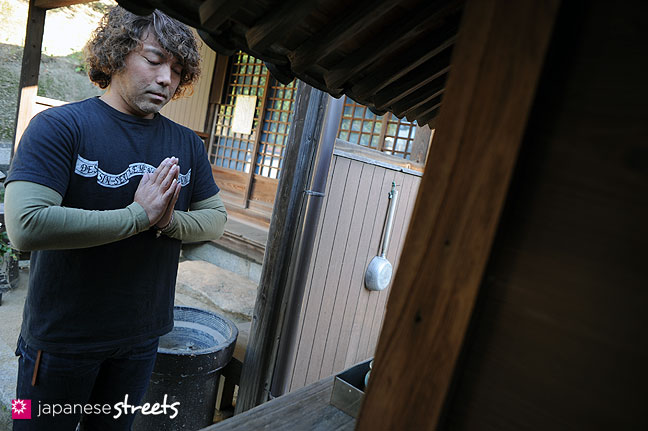
STUDIO D’ARTISAN’s chief designer Takeshi Kawata
The Osaka 5 give almost obsessive attention to these details.
“Rivets should be made of copper so they eventually get a green-blue color,” says Yamane. “Buttons should be zinc, so they turn white.”
“We usually use 6 different thicknesses for the threads used in sewing,” says Takeshi Kawata, chief designer of STUDIO D’ARTISAN. ”Because jeans shrink, we also calculate the needle width very carefully. Depending on the location on the jeans, there are 6, 8 or 10 stitches per inch.”
Showing a similar concern for the stitch, Yamane displays a pair of old faded EVISU jeans. The hemline’s fading is interrupted at regular intervals, creating a playful display. “That only happens when you use a chain stitch,” he explains proudly.
The attention to detail extends to the type of cotton that each company insists on using. “For our best jeans, we only use Memphis cotton,” says STUDIO D’ARTISAN’s Kawata. FULLCOUNT’s Tsujita however, swears by Zimbabwe cotton. “It is handpicked, therefore much cleaner and whiter. Because only one crop per year is grown, the cotton grows much bigger. You get a long and fine thread which creates softer, lighter and more durable clothes.”
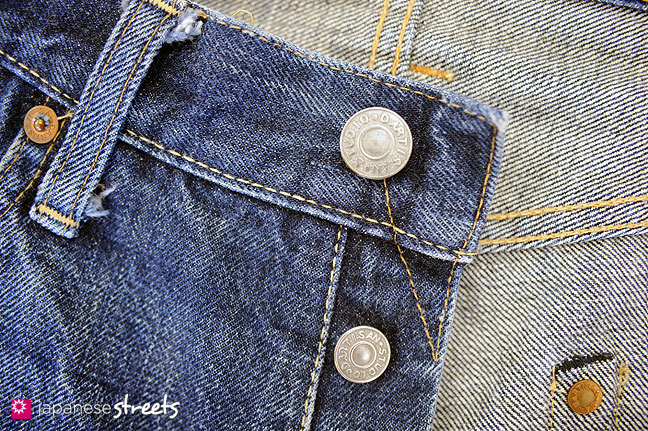
STUDIO D’ARTISAN jeans. The Osaka 5 pay almost obsessive attention to detail
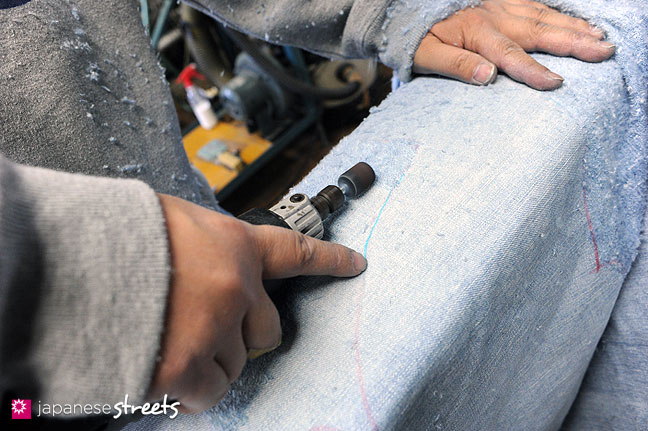
Aging jeans at Kouritsu, STUDIO D’ARTISAN’s owner
The pioneers’ great advantage in being able to recreate vintage denim has been old power looms that were collecting dust at small factories in nearby Okayama Prefecture. The area had developed itself as a manufacturer of student uniforms, but with baby boomers grown up and families becoming smaller, business was bad. When they were approached to recreate vintage denim, they were both available and delighted.
Since the five first pioneered vintage jeans, the market has greatly changed. The Japanese vintage jeans boom of the late 90s enticed a large number of companies to jump onto the bandwagon. When this boom started to fade, many Okayama factories started to create their own brands. The well-known brand Momotaro was for example begun by Collect, the textile mill that first worked with FULLCOUNT.
Large companies have taken over two of the pioneers. STUDIO D’ARTISAN was purchased by an Okayama company, and Denime by entrepreneur Hitoshi Tsujimoto, who in the late 1980s developed his own vintage jeans line for his fashion retail chain Nylon.
Tsujimoto has cut out companies like Kurabo and Kaihara and contracts directly with dozens of small factories. This has allowed him to change the production process. “We make so much denim at one time that we can control the quality better while reducing the cost. Before I bought Denime, the company’s jeans sold for 35,000 yen (351 euro), now they’re 25,000 yen (250 euro). But it takes a lot of money.” With 16 companies in his portfolio, money however seems hardly a problem for this astute businessman.

Denime owner Hitoshi Tsujimoto
This gives the impression that from now on the focus will be on profits, no longer on the quest to create the perfect jeans. However, with Denime no longer in the hands of World, Hayashi has left the company. In 2010, he set up a new company, RESOLUTE. “My aim is to make a perfect replica of the Levi’s 501,” the 55-year old Hayashi says with fire in his eyes. “Nobody has achieved that yet.” Perhaps, the race for the perfect jeans is back on again…
Also read Jeans Revolution for some context about how unlikely Osaka was as the birthplace of the global jeans revolution.

FULLCOUNT jeans
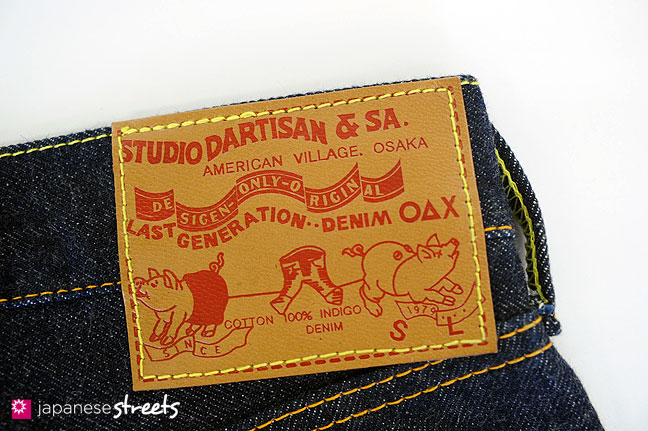
STUDIO D’ARTISAN jeans. The Osaka 5 pay almost obsessive attention to detail

Samples of used jeans hang on the wall at STUDIO D’ARTISAN design office in Okayama city

An employee of Kouritsu, STUDIO D’ARTISAN’s owner, tests a denim aging process

Aging jeans at Kouritsu, STUDIO D’ARTISAN’s owner

Aging jeans at Kouritsu, STUDIO D’ARTISAN’s owner

Aged jeans at Kouritsu, STUDIO D’ARTISAN’s owner
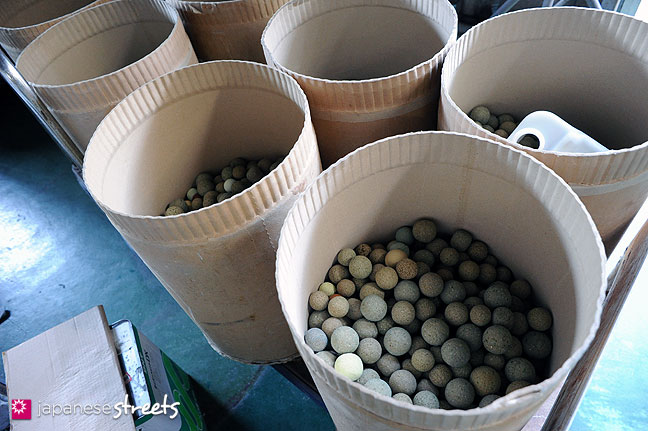
Buckets of stone balls at Oyama based Kouritsu. Jeans are washed with these balls to age them
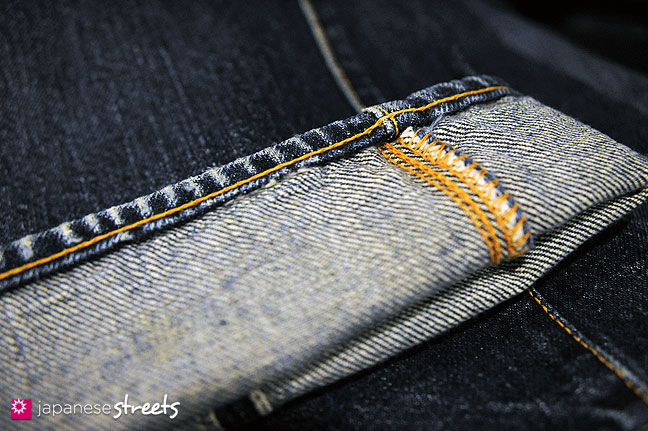
Detail of the hemline of used EVISU jeans. The fading is interrupted at regular intervals, creating a playful display. “That only happens when you use a chain stitch,” explains owner Yamane.

The EVISU flagship store in Osaka

Welcome room at Denime’s headquarters in Kobe
Top Photo: Stock of vintage jeans at Denime’s headquarters in Kobe


 About the Author
About the Author
Comment (日本語もOK)